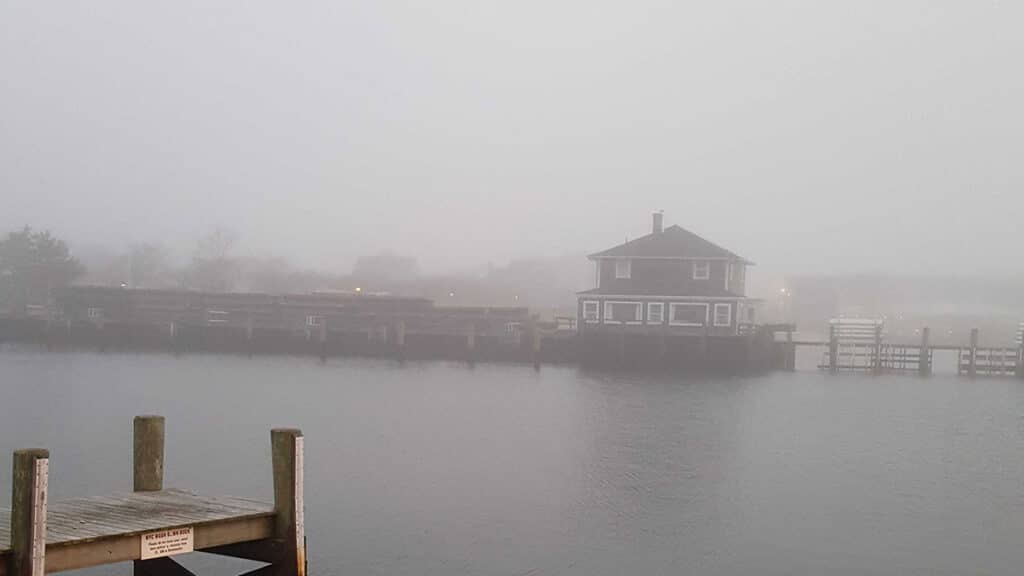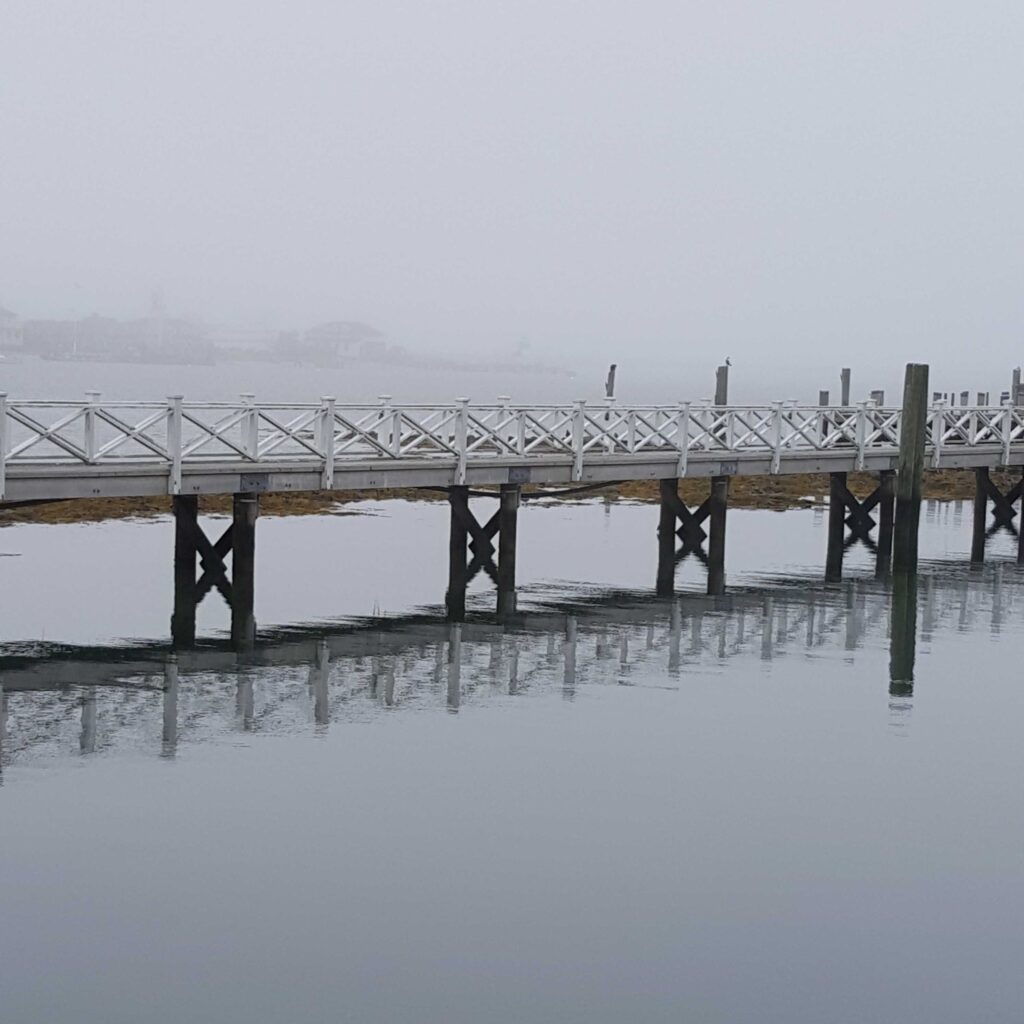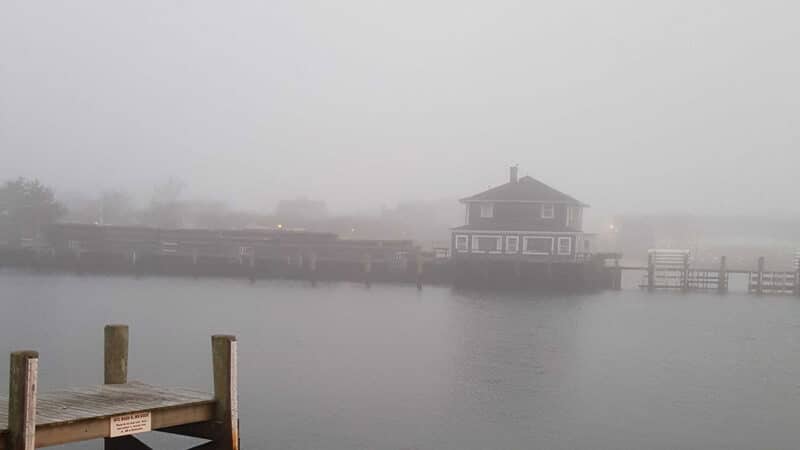by Dr. Sarah Treanor Bois
Director of Research & Education at the Linda Loring Nature Foundation
“The Little Grey Lady of the Sea” is how we’re known. How many business names around Nantucket have something to do with “Grey Lady”? And it’s not just the gray shingles. Benjamin Moore even has a beautiful blue grey paint color called ‘Nantucket Fog.” On Nantucket, we literally live and breathe fog.
There is a certain mystery about fog. It sets a tone for a story. An evening fog can be a bit spooky. A morning fog can be a charming, cool walk in the summer. “Fog is a cloud that touches the ground.”
With all of its historic charm, downtown Nantucket already resembles a bygone era. If you look too close, though, you get caught up in high-end clothing stores and art galleries. When the fog rolls in, it blurs the edges a bit and can transport you back to an earlier century. Using that lens, not too much has changed.

Sometimes, the fog can be a nuisance: when you’re driving and can’t see the road, when you finally get to the beach on your day off, or when fog marrs the view for a perfect photo. Here on Nantucket, it’s not just that the fog appears frequently, it runs our lives to some extent. The planes don’t fly in the fog. Flights are delayed, connections missed, as we are subject to the elements. The boat goes slower, the drivers slow down – the fog sets the pace. How many newspapers or “overnight” mail have been delayed because of fog? Those are just minor inconveniences. Yes, our lighthouses are charming, but remember why they are there. They are warning lights. In the dark and in fog, a ship might not see our small grey lady, her shoals and other hazards. The fog hides things.
One of the most famous shipwrecks in our waters is the Andrea Doria. This Italian ship collided with the Swedish ocean liner, Stockholm, in a heavy Atlantic fog in 1956. Imagine two huge ocean liners that couldn’t navigate around each other because of thick fog. They were already on a collision course, but the fog was so thick that by the time visual contact was made, it was too late to course-correct. Fifty-one passengers and crew were killed in the collision. This incident remains the worst maritime disaster to occur in US waters since 1915.
A thick, “pea soup” fog was also blamed for the sinking of a Nantucket Lightship boat LV-117 in 1934. The Lightship, which was moored purposely to warn ships of the shallow shoals around the south part of the island, was cut in half by the White Star ocean liner Olympic, the sister ship to the Titanic. Seven lives were lost in that accident.
So, what causes all of this charming, but deadly fog? Well, it is true that fog is basically a cloud on the ground. Clouds, however, can form at any altitude even as high as 12 miles above sea level. So think about that the next time you’re on a plane and see all the white fluffy clouds up close. If you’ve ever taken a walk in the fog, you now know what a swim in those clouds would feel like. But how do they actually form and why?

Fog occurs when it’s very humid, much like we’ve been experiencing the past few weeks. We see fog when water vapor in the air condenses. Water vapor, as a gas, is invisible. In order for fog to form, dust or other particles (sometimes pollution) needs to be in the air. The water vapor condenses around the particles, leaving tiny droplets of water hanging in the air. Sea fog, which is what we primarily experience, shows up near bodies of salty water. This type of fog is formed as water vapor condenses around bits of sea salt.

Another type of fog, radiation fog, is also known as “ground fog.” This forms on clear nights with light wind. As the earth releases the warm air it absorbed throughout the daytime, the ground cools and, in turn, cools the air. If it is completely still, the result is dew. With air movement, condensation in the air creates mist or fog. This is the kind that hangs low. It “burns off” as the sun rises and begins to, again, warm the earth.
Our vegetation and animals have adapted to living on a remote sandy island and benefit from the regular fog. Even in a drought condition with little to no rainfall, thick, heavy fog can condense further on vegetation and leave the landscape dripping wet. This gives plants some moisture to hold off wilting. There have been more than a few summers where the rest of the state was under technical drought conditions, but Nantucket wasn’t, primarily due to the influence of regular fog events. This moisture availability also helps out insects, small mammals, and birds who can take advantage of the moisture left on vegetation.
Of course, if you are a farmer or gardener, not only does fog not eliminate the need to water the roots, but it also might subject your crops to various fungus rot, and other blights brought on by moisture on the leaves. Powdery mildew and tomato rot are common afflictions of this sort.
Sailors are usually more worried about advection fog, which is formed when relatively warm, moist air flows over colder surface water. Sometimes called “sea fog,” this type of fog can occur anytime of the day and even in strong winds.
As a fisherman and boat captain, my husband has said how different a fishing trip is in the fog. Sometimes the fog can help fishing. The stripers are more active closer to the surface as the light from the sun is blocked. It’s the other boaters, especially pleasure boaters, that put him on edge. He has radar which can show other vessels nearby. Go slow and collisions can be avoided. But it’s everyone else you have to look out for. This time of year many pleasure boats are driven by inexperienced mariners. If a fog rolls in unexpectedly, lots of vacation-boaters are stuck. They may blindly follow their GPS back to the harbor, but without radar, they can’t tell if there are other boats in the area until they are right in front of (or on top of) them. There have been many close calls!

Lately on Nantucket, many beach goers have settled on their blanket for a long, sunny day at the beach only to be suddenly inundated by a fog bank. This happened to me last weekend on the south shore. The fog hung for a bit and then unceremoniously “burned off.” So, what caused it? These beach fogs are caused by a classic trifecta: warm summer air temperatures, cooler ocean water, and high humidity due to tropical moisture coming in from the south. The higher humidity means more water vapor in the air to form fog. Further inland, the temperatures are just as high, but there isn’t the same tropical air and the land surface is warmer.
For those who find themselves in this kind of fog while on shore or in a boat. As the old saying goes, “If you don’t like the weather, just wait a minute.” Chances are, the fickle fog will vanish soon enough.



